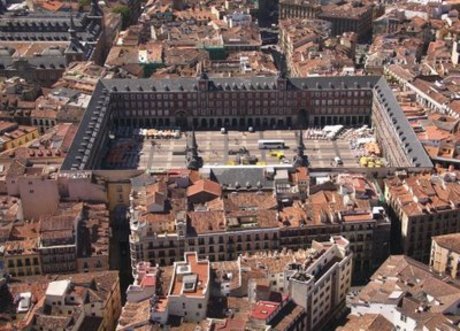Plaza Mayor
The Plaza Mayor is Madrid's main square. It is located right in the center of the city, just a few minutes walk from the Puerta del Sol.
The Plaza Mayor was built during the Habsburg period and is a central plaza in the city of Madrid, Spain. It is located only a few blocks away from another famous plaza, the Puerta del Sol. The Plaza Mayor is rectangular in shape, measuring 129 by 94 meters, and is surrounded by three-story residential buildings having 237 balconies facing the Plaza. It has a total of nine entranceways. The Casa de la Panadería, serving municipal and cultural functions, dominates the Plaza Mayor.
The origins of the Plaza go back to 1576 when Philip I asked Juan de Herrera, a renowned Classical architect, to discuss a plan to remodel the busy and chaotic area of the old Plaza del Arrabal. Juan de Herrera was the artist who designed the first project in 1560 to remodel the old Plaza del Arrabal but construction did not start until 1617, during Philip III's reign. The king asked Juan Gomez de Mora to continue with the project, and he finished the porticoes in 1619. Nevertheless, the Plaza Mayor as we know it today is the work of the architect Juan de Villanueva who was entrusted with its reconstruction in 1790 after a spate of big fires. Giambolognats equestrian statue of Philip III dates to 1616, but it was not placed in the center of the square until 1848.
The name of the plaza has changed over time. Originally it was called the "Plaza del Arrabal" but became known as the "Plaza Mayor".
In 1812, following a decree all the major plazas of Spain were renamed "Plaza de la Constitución", in honor of the Constitution of 1812. The plaza had this name until the restoration of the Borbón king in 1814 when it became known as the "Plaza Real". The plaza once again held the name "Plaza de la Constitución" in the periods from 1820 to 1823, 1833 to 1835, and 1840 to 1843.
In 1873, the name changed to "Plaza de la República", and then back to "Plaza de la Constitución" from the restoration of Alfonso XII in 1876 to the dictatorship of Primo de Rivera in 1922. A proclamation of the Second Spanish Republic gave the plaza the name of "Plaza de la Constitución" until the end of the Spanish Civil War when the plaza was renamed the "Plaza Mayor," the name it bears to date.
The Plaza Mayor has been the scene of multitudinous events: markets, bullfights, soccer games, public executions, and, during the Spanish Inquisition, "autos de fe" against supposed heretics and the executions of those condemned to death. The Plaza Mayor also has a ring of old and traditional shops and cafes under its porticoes. Celebrations for San Isidro, patron saint of Madrid, are also held here. The Plaza Mayor is now a major tourist attraction, visited by thousands of tourists a year.
Despite the rather high prices charged by the restaurants and cafés under the arches that skirt the square, this is still a marvelous place to sit out, try some good Spanish wine, sample some tasty tapas and watch the passers-by.
The square was originally planned by Felipe II and his architect Juan de Herrera, but was inaugurated in 1620 during Felipe III's reign, whose statue sits proud in the very center of the square. Juan Gómez de Mora gave it its rectangular form, and after it had suffered three fires Juan de Villanova completed the work in 1853 by joining the four sides.
Over the years, the square has had many different names. Located at the confluence of the paths towards Toledo and Atocha, it was originally the site of the "Plaza del Arrabal" market and thus took this name before later becoming the Plaza Mayor.
Since then it has also been called the Plaza de la Constitución, Plaza Real and Plaza de la República before returning to the now famous Plaza Mayor name at the end of the Spanish Civil War. Public executions, crowning ceremonies, bullfights, Inquisition trials and diverse fiestas have all taken place right here in the square.
The square is mostly surrounded by three-story houses with balconies looking out onto the square and still lived in by the fortunate few.
Located at the north end of the square resides the four-story Casa de la Panadería building, supposedly named after the bakery it replaced.
The construction of this building and its colorful facade of frescos was initiated in 1590 and it has been renovated several times over the years, most recently when the frescos were repainted with designs by Carlos Franco, in 1992. You can get there via flight to Madrid.




